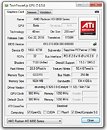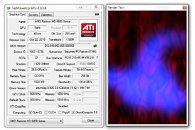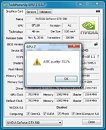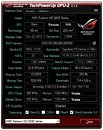Saturday, January 21st 2012

TechPowerUp GPU-Z 0.5.8 Released
TechPowerUp today released the latest version of GPU-Z, our popular video subsystem information and diagnostic utility that provides you with accurate information about the graphics hardware installed, and lets you monitor their clock speeds, fan speeds, voltages, VRAM consumption, etc., in real-time. Version 0.5.8 introduces two new features. The first one is a render test that applies sufficient load (not stress) on the GPU to pull it out of PCI-Express link-state power-management, to ensure the Bus information is accurate. If you find the PCI-Express bus link speed or PCIe version displayed incorrectly, simply click on the "?" button next to the field to launch the load test.
The next new feature is ASIC quality, designed for NVIDIA Fermi (GF10x and GF11x GPUs) and AMD Southern Islands (HD 7800 series and above), aimed at advanced users, hardware manufacturers, and the likes. We've found the ways in which AMD and NVIDIA segregate their freshly-made GPU ASICs based on the electrical leakages the chips produce (to increase yield by allotting them in different SKUs and performance bins), and we've found ways in which ASIC quality can be quantified and displayed. Find this feature in the context menu of GPU-Z. We're working on implementing this feature on older AMD Radeon GPUs.DOWNLOAD: TechPowerUp GPU-Z 0.5.8, TechPowerUp GPU-Z 0.5.8 ASUS ROG Themed
The full change-log follows.
The next new feature is ASIC quality, designed for NVIDIA Fermi (GF10x and GF11x GPUs) and AMD Southern Islands (HD 7800 series and above), aimed at advanced users, hardware manufacturers, and the likes. We've found the ways in which AMD and NVIDIA segregate their freshly-made GPU ASICs based on the electrical leakages the chips produce (to increase yield by allotting them in different SKUs and performance bins), and we've found ways in which ASIC quality can be quantified and displayed. Find this feature in the context menu of GPU-Z. We're working on implementing this feature on older AMD Radeon GPUs.DOWNLOAD: TechPowerUp GPU-Z 0.5.8, TechPowerUp GPU-Z 0.5.8 ASUS ROG Themed
The full change-log follows.
- Added explanation about PCI-Express power savings and 3D render test to accurately measure bus config under load
- Added function to display ASIC quality for Fermi and Southern Islands. (Located in the GPU-Z system menu)
- Fixed crash on older ATI cards
- Added voltage monitoring for HD 7970
- Improved real-time clock monitoring for HD 7970
- Fixed OpenCL detection for AMD Antilles, Whistler, Seymour, Blackcomb
- Improved default clock reading for AMD HD 7970 and Fusion
- Added support for AMD FirePro V7900, HD 6930, HD 7690M, HD 6410D
- Fixed Intel Sandy Bridge IGP to be DirectX 10.1, 32 nm
- Added support for NVIDIA Tesla C2075, GeForce GT 630M





135 Comments on TechPowerUp GPU-Z 0.5.8 Released
i push ALT (Left one) and than push arrow down but nuth happens, do i need to set keyboard language to english or what is wrong here?
will be there any future update for older cards?
I now vote we should have a ASIC quality performance table! :)
i am using beta driver 290.36 is the driver an issue or my ASIC is just terrible low?
EVGA GTX 580 3072 MB
ASIC quality: 72.3%
Stock VDDC: 1.016v
OC 1.113v @900/4600MHz
VDDC as measured by GPUZ. 3D mode, no load.
ASIC quality is 83.1%
under water btw. on air i maxed at 825 before the fan speed was to annoying.
102.6% is the lowest.
If you do feel like to change it anyway, could you specifically list the RAW value (i.e. decimal value from the binary) on the screen, besides the percentile? This could avoid confusion and when trading second-hand graphics cards we could ask for a screenshot with the later version of GPU-Z, to avoid confusion with the abolished 0.5.8.
Look at it this way, let's say there's an imperfect car manufacturing company, and not all the cars that come out of it have perfectly aligned and balanced wheels, and so to "increase yields", the car maker puts its cars (at the factory), through corrective studs that will align/balance out wheels.
Not all GPUs are born equal, not even in the same wafer. Some have higher electrical leakage, some have low. So to correct them in the fab, their degree of leakage are measured and corrective fuses are added to the GPU package, and correct VID set for the chip's leakage characteristics. Later, NVIDIA/AMD segregate "good" chips from "normal" based on leakage/VID, the "good" ones are put into higher bins, the "normal" ones go to reference / low-factory-OC cards, the "good" ones go to high-factory-OC cards. Multiple SKUs based on the same physical GPU are also carved out this way. "normal" ones go to lower SKUs, "good" ones go to higher SKUs.
It seems like gt problem wif my EAH6850V2~
No Vcore~
and None-stop running the stress test ~